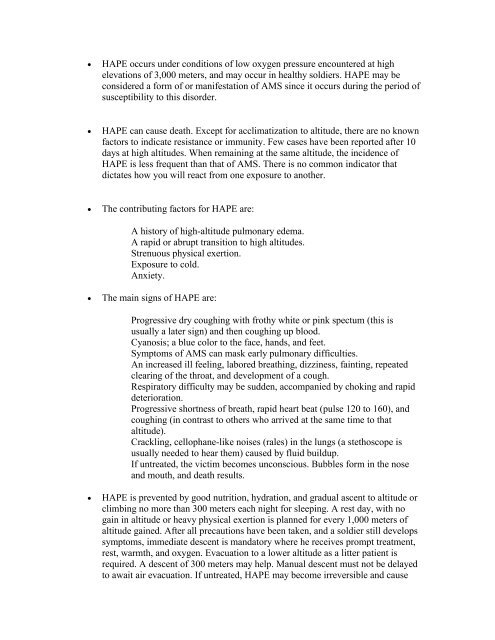US Army mountaineering techniques (basic)
US Army mountaineering techniques (basic)
US Army mountaineering techniques (basic)
You also want an ePaper? Increase the reach of your titles
YUMPU automatically turns print PDFs into web optimized ePapers that Google loves.
HAPE occurs under conditions of low oxygen pressure encountered at high<br />
elevations of 3,000 meters, and may occur in healthy soldiers. HAPE may be<br />
considered a form of or manifestation of AMS since it occurs during the period of<br />
susceptibility to this disorder.<br />
HAPE can cause death. Except for acclimatization to altitude, there are no known<br />
factors to indicate resistance or immunity. Few cases have been reported after 10<br />
days at high altitudes. When remaining at the same altitude, the incidence of<br />
HAPE is less frequent than that of AMS. There is no common indicator that<br />
dictates how you will react from one exposure to another.<br />
The contributing factors for HAPE are:<br />
A history of high-altitude pulmonary edema.<br />
A rapid or abrupt transition to high altitudes.<br />
Strenuous physical exertion.<br />
Exposure to cold.<br />
Anxiety.<br />
The main signs of HAPE are:<br />
Progressive dry coughing with frothy white or pink spectum (this is<br />
usually a later sign) and then coughing up blood.<br />
Cyanosis; a blue color to the face, hands, and feet.<br />
Symptoms of AMS can mask early pulmonary difficulties.<br />
An increased ill feeling, labored breathing, dizziness, fainting, repeated<br />
clearing of the throat, and development of a cough.<br />
Respiratory difficulty may be sudden, accompanied by choking and rapid<br />
deterioration.<br />
Progressive shortness of breath, rapid heart beat (pulse 120 to 160), and<br />
coughing (in contrast to others who arrived at the same time to that<br />
altitude).<br />
Crackling, cellophane-like noises (rales) in the lungs (a stethoscope is<br />
usually needed to hear them) caused by fluid buildup.<br />
If untreated, the victim becomes unconscious. Bubbles form in the nose<br />
and mouth, and death results.<br />
HAPE is prevented by good nutrition, hydration, and gradual ascent to altitude or<br />
climbing no more than 300 meters each night for sleeping. A rest day, with no<br />
gain in altitude or heavy physical exertion is planned for every 1,000 meters of<br />
altitude gained. After all precautions have been taken, and a soldier still develops<br />
symptoms, immediate descent is mandatory where he receives prompt treatment,<br />
rest, warmth, and oxygen. Evacuation to a lower altitude as a litter patient is<br />
required. A descent of 300 meters may help. Manual descent must not be delayed<br />
to await air evacuation. If untreated, HAPE may become irreversible and cause

















